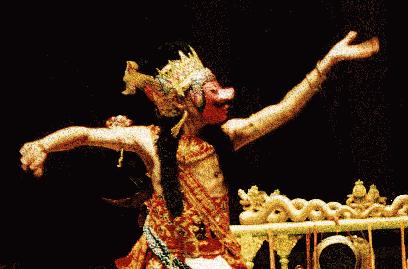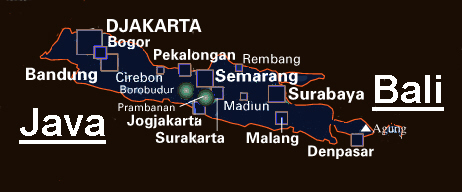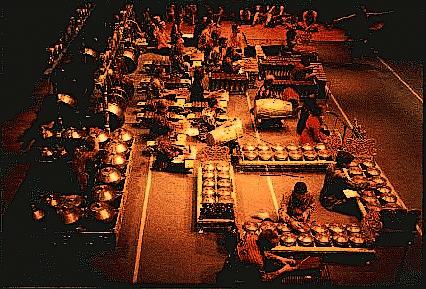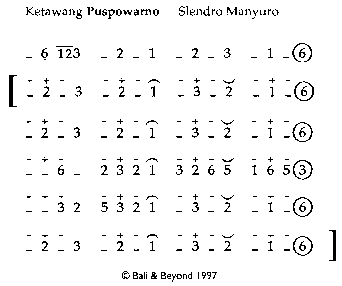|

up
|
The Javanese Gamelan
|

|
This is a web-page about Javanese Gamelan. I've put this web-page on
my site because a lot of people ask "Java ? Gamelan ? Ohhh dear I
haven't got this new Java Applet !". So Warning !!! This is
not a web-page about Java Applets. This is a web page about
"Javanese Gamelan incredible music".
The Gamelan is the name of the orchestra based on metallic
percussion of the islands of Java, Bali and Sunda
in the South of Indonesia. The Gamelan I will speak here about,
is the one from Solo (Surakarta) and Jogja
(Jogjakarta) of Java and most precisely the "Sekar
Wangi".
 |
Map of South-Indonesia |
The gamelan is composed of a series of melodic-percussive instruments. Each of them have a specific functions inside the orchestra. Those instruments are :
- The Picking, the Saron, the Demung and the
Slenthem plays the melodic part of the music. We call them the
Balungan. The Picking, the Saron, and the
Demung are kind of metallophones tuned at decreasing
octaves. The Slenthem is a suspended metallophone playing at a
low pitch.
- The Bonang Barung, the Bonang Penerus, and the
Gender which play variations uppon this melodic part. The
Bonangs are horizontal gongs, and the Gender is a two
octaves suspended metallophone.
- The Kenong, the Kempul which ponctuate this melodic
part. The Kenong are horizontal gongs like the Bonangs
but at lower pitch and are usually play with the Kethuk and
Kempyang. The Kempul is a collection of gongs of
different sizes, the biggest one is called the Gong Ageng, the
other ones Gong Suwukan and Kempul.
All those instruments follow the Kendhang or Ciblon
(hand-drums) which direct the whole ensemble. The Gamelan is often
accompanied by soloists such as singer, suling(a wooden flute),
gambang (a xylophone), rebab(a bowed string instrument)
player.
 |
Sekar Wangi's Gamelan played in concert in june 1998
|
The music of the Gamelan is played for various occasions :
- for the court (there are four royal courts in Central
Java, two each in Solo and Jogja; each court has a huge roster of
musicians),
- for the Wayang Kulit (shadow puppet theater),
- ...
The notation is based on numbers :
- the slendro scale is noted "1 2 3 5 6",
- the pelog scale is noted "1 2 3 4 5 6 7".
Consider the fact that those numbers don't designate the same pitch in
both scale. This notation is mainly used for the Balungan, and
for singings. The other instruments have more implicit notation like
"^", ".", "()", "b",
"P", "|", ... Here is an example :
 |
Gamelan notation (courtesy of Bali Beyond) |
Musical forms are defined by their rhythmic cycle. They consist of
major cycles subdivided by smaller cycles called
"gotro", each marked by the striking of successively
smaller gongs, and ended by an important note called
"Seleh". This note determines the inside of the
cycle.
The way the different instruments of the Gamelan superimpose each other is designated by the "Irama" :
- "Irama lancar" (1 note of Piking for 1 note of Balungan),
- "Irama tanggung" (2/1),
- "Irama dados" (4/1),
- "Irama wilet" (8/1),
- "Irama rangkep" (16/1).
There are also distinct melodic modes called "Pathet"
within the division of scale :
- "Pathet Nem", "Pathet Sanga" and "Pathet Manyura" in slendro,
- "Pathet Lima", "Pathet Nem" and "Pathet Barang" in pelog.
To finish there are also different kind of compositions : the "Lancaran", the "Ladrang", the "Srepegan", ... which differ from the overall construction.
All that put together make thing a bit complicated isn't it ?
created by Geoffroy
Peeters
 counted by Web Counter
counted by Web Counter






